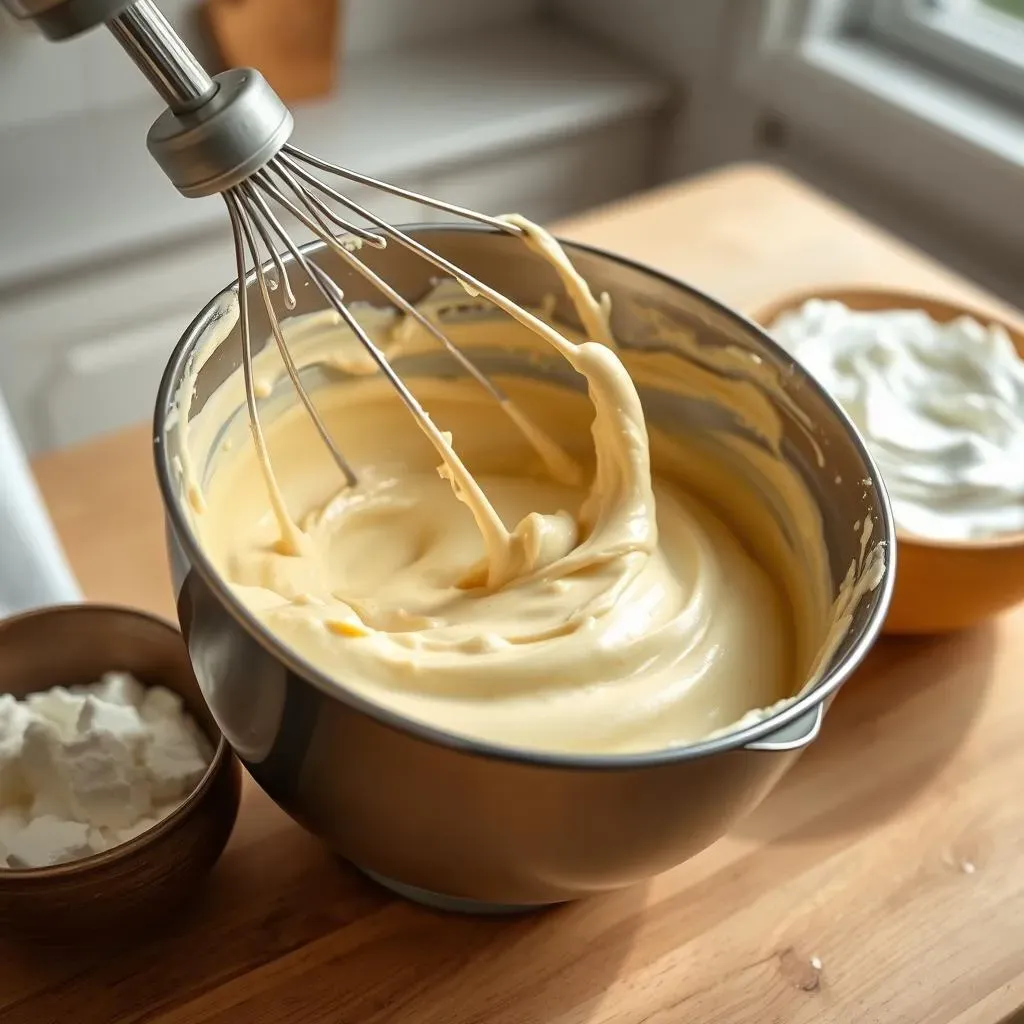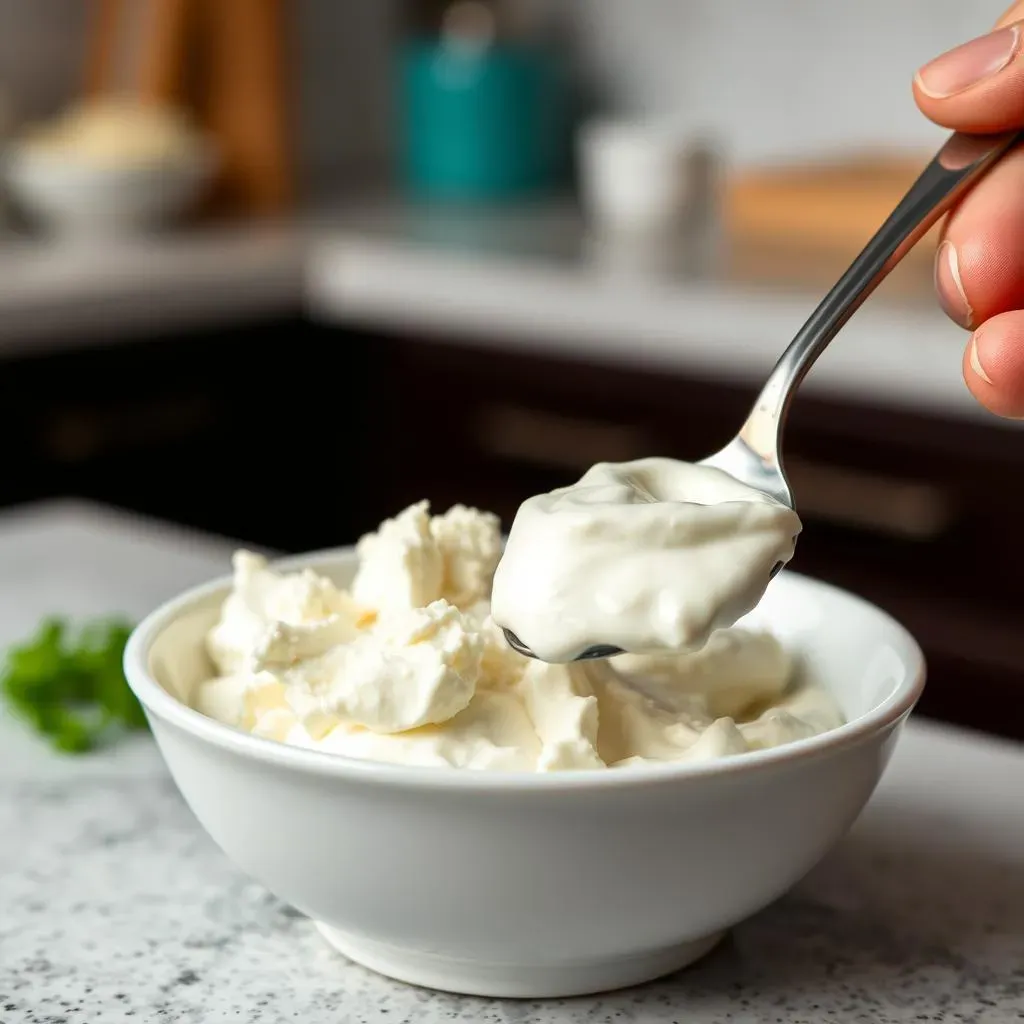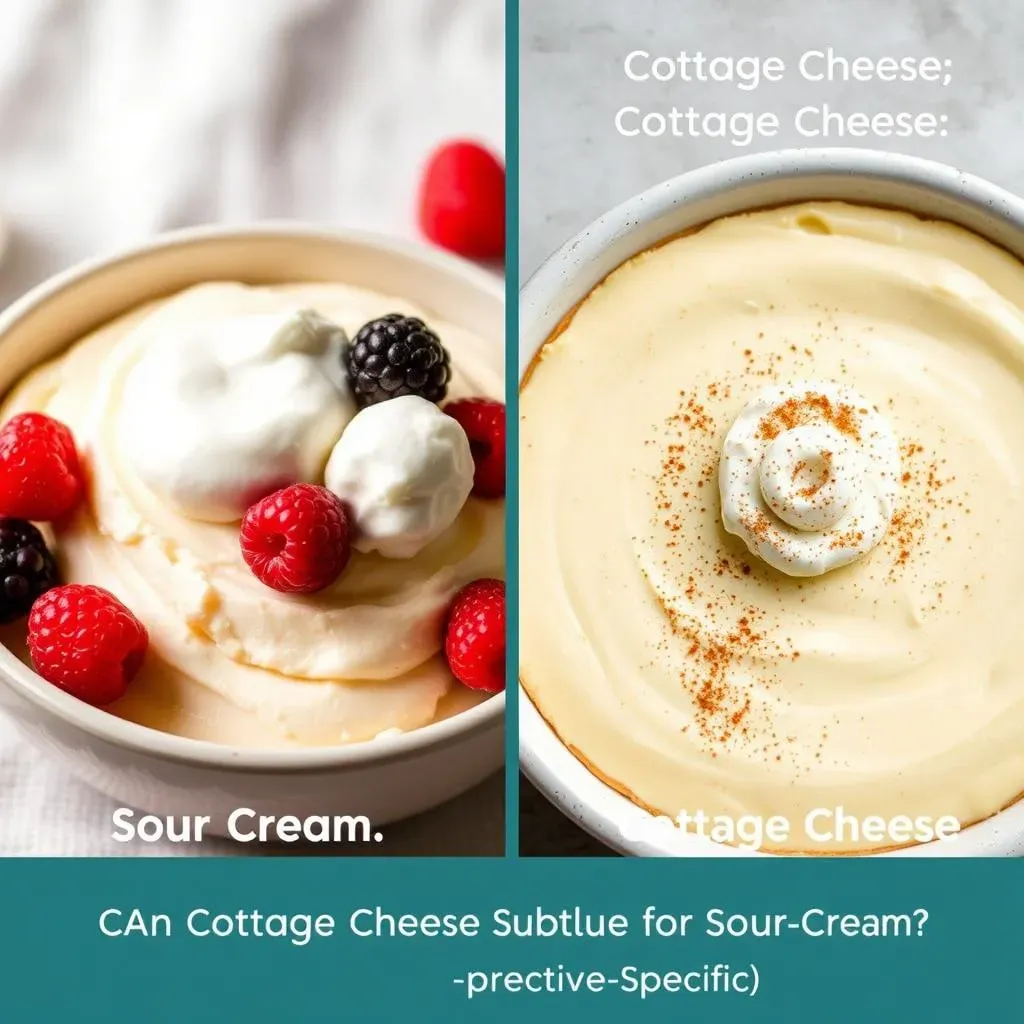Table of Contents
Ever stared blankly into your fridge, recipe in hand, only to discover you're out of sour cream? Don't despair! This article tackles the burning question: can cottage cheese be substituted for sour cream? We'll explore the nuances of this swap, examining whether it's a viable option for both sweet and savory dishes. We'll investigate the impact on texture and flavor when using cottage cheese instead of sour cream, delving into specific recipe types to determine where this substitution shines and where it might fall short. From the creamy swirls in your cheesecake to the tangy dollop on your tacos, we'll help you understand if cottage cheese can successfully step in for sour cream. Get ready to discover the surprising versatility of cottage cheese and learn how to confidently navigate this common cooking dilemma. This comprehensive guide will equip you with the knowledge to make informed decisions about substituting cottage cheese for sour cream, ensuring your culinary creations remain delicious and successful, no matter what your pantry situation.
Can Cottage Cheese Replace Sour Cream in Baking?

Can Cottage Cheese Replace Sour Cream in Baking?
Cottage Cheese in Cakes and Muffins
So, you're wondering if you can swap cottage cheese for sour cream in your baking? The answer, my friend, is a nuanced "maybe." Cottage cheese, with its slightly tangy flavor and unique texture, can surprisingly work well in certain baked goods. Think moist, dense cakes and muffins where a slightly crumbly texture isn't a deal-breaker. The high protein content in cottage cheese can actually contribute to a richer, more tender crumb, but it's crucial to consider the moisture content. Cottage cheese is less fatty than sour cream, so you might need to add a little extra liquid (milk or buttermilk work well) to compensate and achieve the desired consistency. Remember, you're aiming for a smooth batter, not a lumpy mess! Experimenting with small batches is key to finding the perfect balance.
For instance, I once used cottage cheese in a carrot cake recipe, replacing about half the sour cream called for. The result? A deliciously moist cake with a slightly denser texture than the original. It wasn't exactly the same as using sour cream, but it was still absolutely delicious! The slight tanginess of the cottage cheese even complemented the sweetness of the carrots. However, this substitution might not be suitable for recipes that rely on a light and airy texture, like angel food cake. In those cases, sticking with sour cream, or exploring other alternatives like Greek yogurt (buttermilk substitute), is your best bet. Let's explore some specific recipe examples in the next section.
Baked Good | Cottage Cheese Suitability | Notes |
|---|---|---|
Carrot Cake | Good | Adds moisture and richness; may require extra liquid. |
Muffins | Good | Works well in dense, moist muffins. |
Angel Food Cake | Poor | Texture will be significantly altered. |
Cottage Cheese in Cookies and Quick Breads
Now, let's talk about cookies and quick breads. Here, the substitution gets a little trickier. The moisture and texture of cottage cheese can significantly alter the final product. In cookies, cottage cheese might result in a slightly denser, chewier cookie, which some people might enjoy, but others might find undesirable. The tanginess might also clash with certain flavor profiles. Consider the overall flavor profile of your recipe – a cookie with a strong chocolate flavor, for instance, might be able to mask the cottage cheese taste more effectively. Quick breads, on the other hand, might tolerate the substitution better, especially those with a naturally dense texture, like banana bread. However, it's vital to adjust the liquid content carefully; you might need to reduce the amount of other liquids to prevent the bread from becoming too wet.
Before making a full batch, I always recommend making a small test batch. This allows you to assess the changes in texture and flavor without wasting a lot of ingredients. Remember, baking is a science, and sometimes, even small changes can have a big impact! You can easily find more information about buttermilk substitutions online. Ultimately, the success of using cottage cheese as a sour cream substitute in baking depends heavily on the specific recipe and your willingness to experiment. It's all about finding that perfect balance between achieving a desirable texture and maintaining a delicious flavor profile. Let’s move on to the next section and look at how cottage cheese fares in savory dishes.
- Test recipes in small batches first.
- Adjust liquid content as needed.
- Consider the overall flavor profile.
Using Cottage Cheese as a Sour Cream Substitute in Savory Dishes

Using Cottage Cheese as a Sour Cream Substitute in Savory Dishes
Cottage Cheese in Dips and Dressings
Now, let's shift our focus to the savory side of things. Believe it or not, cottage cheese can be a surprisingly effective sour cream substitute in many dips and dressings! Its creamy texture and mild tanginess make it a suitable base for various recipes. Think creamy spinach and artichoke dip, ranch dressing, or even a simple taco dip. The key here is to blend the cottage cheese until it's completely smooth; otherwise, you'll end up with a lumpy mess, which isn't exactly appealing. You might need to add a little extra liquid (milk, buttermilk, or even a touch of mayonnaise) to achieve the desired consistency. A little experimentation goes a long way here!
For a truly smooth and creamy texture, I highly recommend using an immersion blender. It makes quick work of breaking down the cottage cheese curds. However, a regular blender or food processor will also do the trick. Just be sure to scrape down the sides of the container as needed to ensure everything gets thoroughly blended. Remember that you can find more information on buttermilk substitutes if you're looking for additional options. Let's be honest, sometimes we need more than just one option! In the next section, we'll explore some specific examples of how to use cottage cheese in savory dishes.
- Blend until completely smooth.
- Add extra liquid as needed for desired consistency.
- Use an immersion blender for best results.
Cottage Cheese in Sauces and Toppings
Moving beyond dips and dressings, cottage cheese can also work surprisingly well as a sour cream substitute in certain sauces and toppings. For example, in a creamy tomato sauce for pasta, cottage cheese can add a subtle tang and creaminess without overpowering the other flavors. Similarly, it can work as a topping for baked potatoes or chili, although its texture might be slightly different than that of sour cream. You might need to adjust the seasoning to compensate for the subtle differences in flavor, but the results can be quite satisfying. A pinch of garlic powder or onion powder can often help to enhance the savory notes.
However, it's important to note that cottage cheese might not be the ideal substitute for all sauces and toppings. For instance, in a sauce that requires a very smooth and glossy finish, cottage cheese's slightly curdled texture might not be desirable. In those cases, other alternatives, like Greek yogurt or crème fraîche, might be better choices. If you're unsure, always start with a small test batch to see how the cottage cheese affects the final product. Remember, the best way to learn is to experiment! And if you need even more options, check out articles on buttermilk for sour cream. The world of substitutions is vast and exciting.
Dish | Cottage Cheese Suitability | Notes |
|---|---|---|
Pasta Sauce | Good | Adds creaminess and subtle tang. |
Baked Potato Topping | Fair | Texture differs from sour cream; adjust seasoning. |
Glossy Sauces | Poor | Texture may not be suitable. |
Texture and Flavor Considerations: Cottage Cheese vs. Sour Cream

Texture and Flavor Considerations: Cottage Cheese vs. Sour Cream
Texture Differences: A Side-by-Side Comparison
Let's be honest, the most obvious difference between cottage cheese and sour cream lies in their texture. Sour cream boasts a smooth, almost velvety consistency. It's perfectly creamy and easily spreadable, making it ideal for dollops and swirls. Cottage cheese, on the other hand, has a noticeably curdled texture. It's made up of small, individual curds suspended in a whey-like liquid. While this texture can be pleasant in some applications, it's definitely not the same as sour cream's smooth elegance. This textural difference is crucial to consider when deciding whether to substitute one for the other. A smooth sour cream sauce will not magically become smooth by substituting it with cottage cheese. The curds will remain. You'll need to blend the cottage cheese into a smoother consistency if you intend to use it in place of sour cream, and even then, it may not be exactly the same.
Think about it like this: imagine trying to make a smooth, creamy frosting with chunky peanut butter instead of creamy peanut butter. You *could* do it, but it would require a lot of blending, and the final product just wouldn't have the same smooth texture. Similarly, while you can blend cottage cheese to a smoother consistency, it will never truly replicate the inherent smoothness of sour cream. This is why choosing the right substitution depends heavily on the recipe's texture requirements. If you're looking for a smooth, creamy texture, then you might need to consider other alternatives like Greek yogurt or buttermilk as a sour cream substitute. Let's delve a little deeper into the flavor profiles in the next section.
Characteristic | Sour Cream | Cottage Cheese |
|---|---|---|
Texture | Smooth, creamy | Curdled, slightly grainy |
Fat Content | High | Moderate |
Flavor | Tangy, slightly acidic | Mildly tangy, slightly buttery |
Flavor Profiles: Subtle Differences, Big Impact
While both cottage cheese and sour cream offer a touch of tang, their flavor profiles aren't identical. Sour cream possesses a sharper, more pronounced tanginess. It's a bright, acidic flavor that cuts through richness and adds a delightful zest to both sweet and savory dishes. Cottage cheese, on the other hand, has a milder, more subtle tang. It's often described as having a slightly sweet and buttery undertone, which can be a pleasant addition to certain recipes but might not be suitable for others. This subtle difference in flavor can significantly influence the overall taste of your dish. For example, in a delicate dessert, the buttery notes of cottage cheese might clash with other flavors, whereas the sharper tang of sour cream would likely complement the sweetness better.
Consider this analogy: think about the difference between a sharp cheddar cheese and a mild Monterey Jack. Both are cheeses, both offer a distinct flavor, but they're not interchangeable in every recipe. Similarly, while both cottage cheese and sour cream contribute tanginess, the intensity and nuances of their flavors differ enough to impact the final result. If the recipe relies heavily on the sharp tang of sour cream, substituting cottage cheese might result in a less vibrant, less flavorful dish. In such cases, it's better to stick with sour cream or explore alternatives with a similar flavor profile, like Greek yogurt or even a buttermilk substitute. Remember, understanding these subtle differences is crucial for making informed substitutions and achieving delicious results. Next, we will look at a recipe-specific approach.
- Sour cream has a sharper tang.
- Cottage cheese has a milder, buttery tang.
- Consider flavor profiles when substituting.
Can Cottage Cheese Substitute for Sour Cream? A RecipeSpecific Approach

Can Cottage Cheese Substitute for Sour Cream? A RecipeSpecific Approach
Cakes and Cheesecakes: A Creamy Conundrum
Let's dive into the world of cakes and cheesecakes. Here, the cottage cheese-for-sour-cream swap gets particularly interesting. In cheesecakes, the creamy texture of sour cream is crucial for achieving that signature smooth, dreamy consistency. Cottage cheese, with its curdled texture, presents a challenge. While you *can* blend it to a smoother state, it's unlikely to achieve the same velvety texture as sour cream. The result might be a slightly grainier, less luxurious cheesecake. However, if you're aiming for a denser, more rustic cheesecake, cottage cheese could surprisingly work. The slight tang might even add an interesting twist to the classic recipe. But, if you're a purist who craves that perfectly smooth cheesecake, then stick with sour cream or explore other alternatives like Greek yogurt.
In cakes, the impact of cottage cheese is less dramatic. The moisture content of cottage cheese can contribute to a moist, dense cake, which can be a desirable trait in some recipes. However, remember to adjust the liquid content accordingly, as cottage cheese is less fatty than sour cream. In recipes that call for a lighter, fluffier cake, the substitution might not be ideal. Experimenting with small batches is key to finding the right balance. If you're looking for more information on buttermilk as a substitute, there are plenty of resources available online. Let's move on to another recipe category.
Recipe Type | Cottage Cheese Suitability | Considerations |
|---|---|---|
Cheesecake | Conditional | Texture will be denser; blend thoroughly. |
Pound Cake | Good | Adds moisture; adjust liquid as needed. |
Angel Food Cake | Poor | Texture will be drastically altered. |
Savory Dishes: From Tacos to Dips
Now let's tackle savory dishes. In recipes like tacos or chili, where sour cream is often used as a topping, cottage cheese can be a surprisingly acceptable substitute, especially if you're looking for a slightly healthier option. The mild tanginess complements spicy flavors well, and the creaminess adds a nice textural contrast. However, remember that the texture will be different; cottage cheese is not as smooth as sour cream. Blending the cottage cheese is crucial to minimize the curdled texture, and you might need to adjust the seasoning to account for the subtle flavor differences. Adding a bit of lime juice can help mimic the sharper tang of sour cream, if needed.
In dips and sauces, cottage cheese can also be a good choice, but again, blending is essential. For example, in a creamy spinach and artichoke dip, cottage cheese can provide a creamy base, but you'll need to blend it until it's completely smooth. If you're aiming for a truly smooth and luxurious texture, you might want to consider other alternatives. The best buttermilk substitute for sour cream can be found in many online resources, if you're looking for more options. Remember to always taste-test your creation before serving to ensure the flavors are balanced to your liking. Don't be afraid to experiment! Next, we'll look at a few more specific examples.
- Blend cottage cheese until smooth for best results in dips.
- Adjust seasoning to complement flavors.
- Consider texture differences when choosing a substitute.
Beyond the Basics: Creative Applications
Let's get creative! While cottage cheese might not always be a direct swap for sour cream, its unique texture and flavor profile can open up exciting possibilities. Think about using it in unexpected ways. For instance, you could incorporate it into a creamy potato salad, adding a subtle tang and a slightly different texture than a traditional mayonnaise-based salad. Or, try blending it with herbs and spices to create a unique spread for sandwiches or crackers. The possibilities are only limited by your imagination! Remember to always consider the texture and flavor impact when experimenting with new combinations.
Don't be afraid to experiment and adjust seasonings to your preference. Ultimately, the best way to determine if cottage cheese is a suitable substitute for sour cream in a particular recipe is to try it yourself. Start with a small batch, carefully observe the results, and adjust as needed. If you're still unsure, there's always the option of exploring other substitutes, such as Greek yogurt or a good buttermilk substitute. The culinary world is full of exciting possibilities; don't be afraid to explore them!
"The key to successful cooking is experimentation and a willingness to adapt." - Unknown